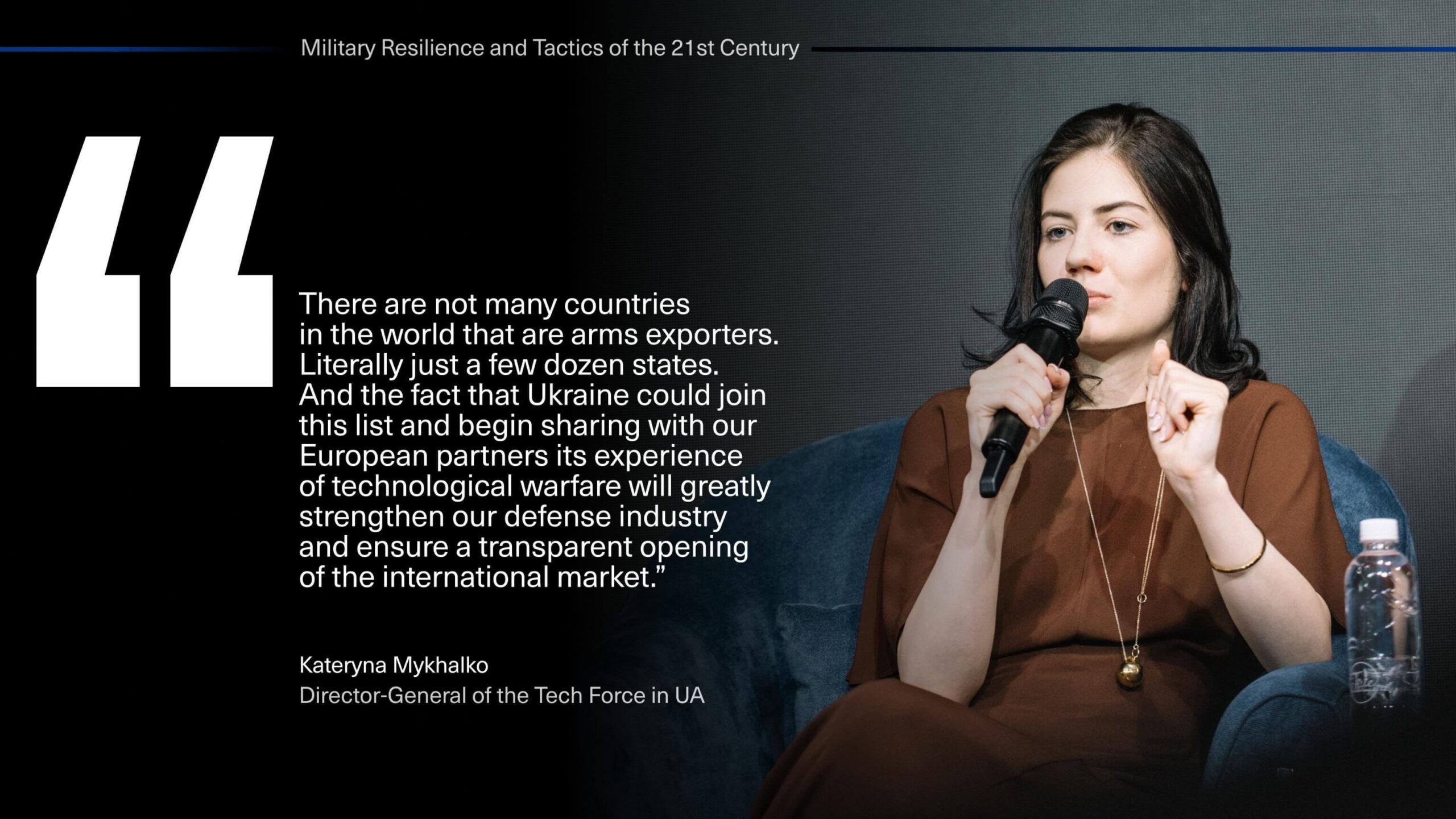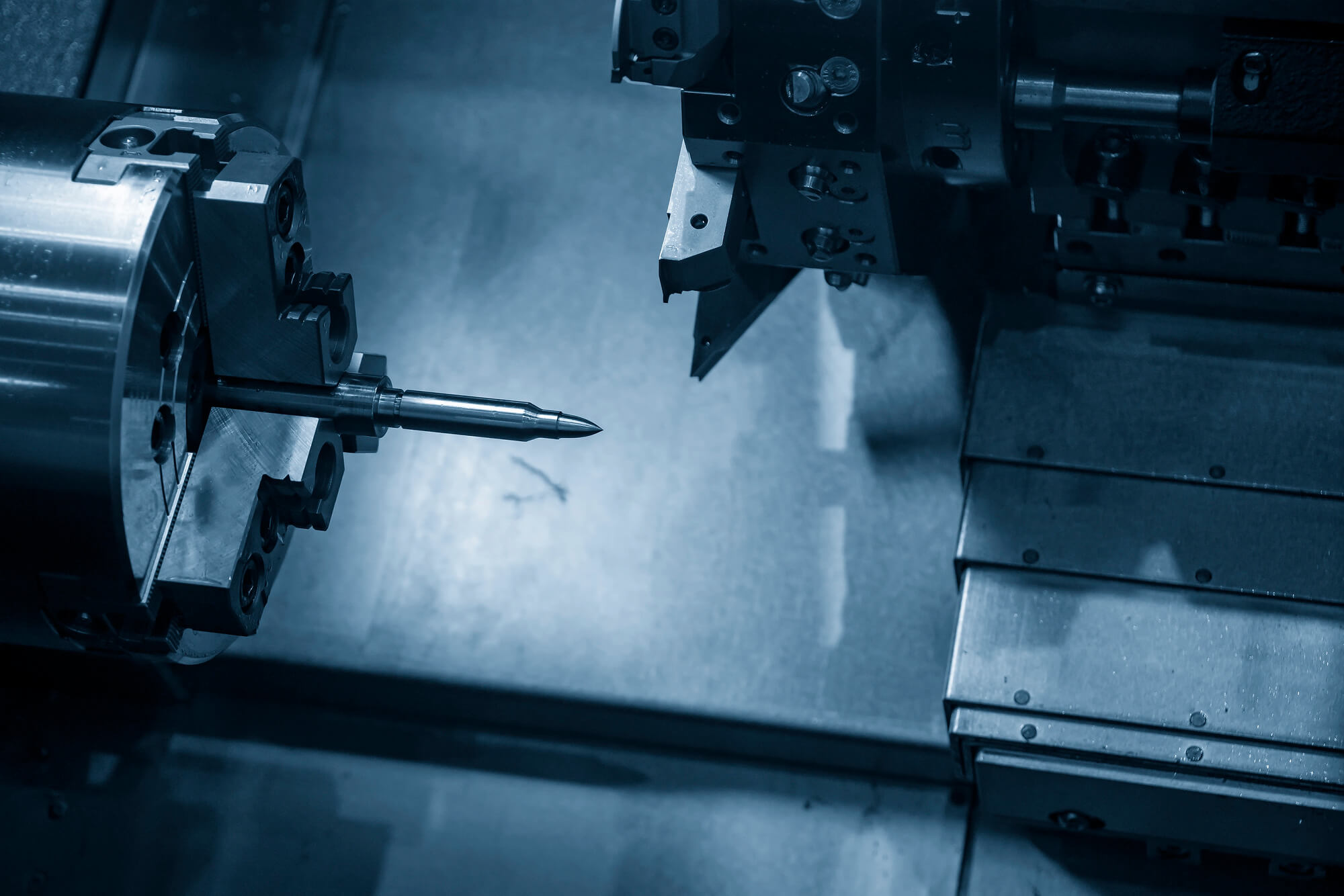Kateryna Mykhalko, Director-General of the Tech Force in UA, took part in the panel discussion “Military Resilience and Tactics of the 21st Century” at the conference “EU. But there is one Twist”. She shared her thoughts on Ukraine’s potential in the international arms market, estimates of economic benefits for the country, and the demand from European partners.
The event was organized by Vox Ukraine with the support of the National Endowment for Democracy (NED) on May 23, 2025. Watch the conference recording here.
Legally open, but in fact closed
Legally, the export of weapons is open, but in practice, it is prohibited. This area involves many stakeholders — the State Export Control Service, the Interagency Commission on Military-Technical Cooperation and Export Control Policy, which includes representatives of law enforcement agencies, and the Ministry of Strategic Industries. Each of these institutions influences exports. A state policy to encourage exporters of high-tech weaponry is needed.
Since innovative weapons are primarily produced by the private sector, not only state-owned companies must be represented abroad. There must be predictable and transparent interaction between the state and the private sector so that the state helps our private companies more actively export their developments, technologies, and expertise to partner countries.
On the request to open arms exports
Representatives of other states and international partners are contacting Tech Force in UA regarding opportunities for cooperation, which are limited by the de facto closed export system.
In their appeal to the President of Ukraine regarding the opening of exports, the Tech Force outlined three key points: first, to launch exports under transparent conditions; second, to ensure equal rules for all companies so that the private sector understands the conditions for obtaining a license and the criteria that must be met to start international cooperation; third, a call for the President to become the chief advocate of our weapons on international markets. After all, arms sales involve systematic engagement with the armies of other countries and diplomatic involvement.
State involvement is essential to ensure that Ukrainian weapons take their place in global markets. On one hand, this means billions of dollars in revenue for our budget; on the other, it shapes Ukraine’s image.

On the shift in perception: from victim to partner
We are witnessing a significant shift in how the Ukrainian industry is perceived. Previously, we used to be beggars for aid, which led to Ukraine being viewed as a victim in this war. Now, we are perceived differently, particularly because cooperation between the European Union and the United States has transformed. The European Union wants to be independent in terms of armaments. They have technologies that Ukraine does not have: strategic weapons, expensive large-scale missiles. At the same time, Ukraine is very strong in asymmetric, low-cost, scalable solutions: drones of all types in all domains (land, air, and sea), electronic warfare (EW) systems, and any tools that help counter drones. Our asymmetric solutions are highly valuable to the European Union and NATO.
As a result, Ukraine has become the only workable solution for the European Union. First and foremost, European countries want to localize drone production within their borders. For example, a Swedish parliament member asked us what legislative changes were needed to localize drone companies in Sweden. However, they are also willing to purchase final products tested on the battlefield. To make this possible, exports need to be opened. The widespread myth is that open exports would discourage partners from helping us. This is not true. On the contrary, partners emphasize that the closure of arms exports limits Ukraine’s cooperation with the European Union in the security domain.
Ukraine can share its experience in asymmetric weaponry and in return obtain financial resources and strengthen its geopolitical role. It can also request that partners localize the production of strategic weapons on Ukrainian territory. This would enable a full-fledged exchange of technologies.
“Regarding export, it’s not just a ready-made drone crossing the border. Security export is a broader philosophy — it’s about how we share and exchange technologies with our partners and export our experience in using these drones.”
We need to start monetizing Ukraine’s major asset because only one other country in the world has comparable experience — Russia. Russian weapons are not for the European Union, but they may appear first in other markets and bring substantial revenues to Russia. That scenario is completely disadvantageous for Ukraine.

On Ukraine’s place in the European market
There are two groups of countries in Europe. The first group lacks a defense industry, such as the Baltic states. They are interested in localizing Ukrainian drone production on their territories. For us, this means revenues. Moreover, the EU has launched the Rearm Europe program, worth €800 billion, and Ukraine can receive a portion of these funds. The second group of countries has its defense-industrial complex, such as France, Germany, and the United Kingdom. Ukraine is interested in partnerships with them because they have technologies that we do not. This could be a technological exchange: they provide us with missiles, we provide them with drones.
“To start joint production, for example, on the territory of Lithuania, a Ukrainian manufacturer must obtain permission from the State Export Control Service. Today, in 100% of cases, companies receive a negative response. Over the years of full-scale war, there has not been a single precedent where a technology was officially exported abroad through the State Export Control Service and legitimate joint production was established on the territory of another European country.”
Does this actually stop companies from international partnerships? No. They relocate abroad, start new research there, and develop products unavailable in Ukraine. The part of the company that can legally relocate abroad does so. In the best-case scenario, Ukraine receives some money, i.e. the companies help finance their production in Ukraine, because they still want us to win this war. Nevertheless, strategically, Ukraine loses these companies, because they will not return after the victory, but will remain in the EU.
They would legally receive permission for joint ventures abroad if exports were open. And this would be a partnership that would ensure tax revenues for Ukraine.
We would like Germany, France, and the UK to localize their defense production in Ukraine. However, there are challenges: Ukraine does not have enough funds to contract 100% of the capacity of its manufacturers. Accordingly, if they enter Ukraine, open production here, and manufacture excess products, they cannot export them back to Germany or the UK. This prevents them from opening production lines in Ukraine. Several major companies were ready to invest hundreds of millions of dollars in Ukraine, but did not launch their production lines because of closed exports. This is a great tragedy, as we are losing production facilities that could have been localized here.

Economy of opportunities
In early 2025, Tech Force in UA launched a tracker of unmade weapons. We calculated how much weaponry could have been produced in 2024 by companies that are members of the Tech Force in UA (specifically referring to drone manufacturers and EW/ESM association), had they worked at full capacity. It turned out that these companies could have produced 1.7 million more drones and EW units, but for some reason the state did not contract these production capacities. If exports had been open last year, Ukraine could have received an additional $2 billion in revenue. There are many other arms manufacturers beyond the Tech Force in UA. Their capacities were probably not fully utilized either.
Meanwhile, our enemy is exporting weapons. They claim to have signed contracts worth $55 billion. That’s a very large number, but even if they exaggerated it fivefold, it’s still tens of billions of dollars. These funds are being invested in their defense industry, and then all of that weaponry is targeted at Ukraine.
Unfortunately, this is a smart strategy on their part. It would also be good for Ukraine to monetize our war experience, since we have far greater moral ground to do so.
Photo: Kateryna Lashchykova
Attention
The author doesn`t work for, consult to, own shares in or receive funding from any company or organization that would benefit from this article, and have no relevant affiliations



